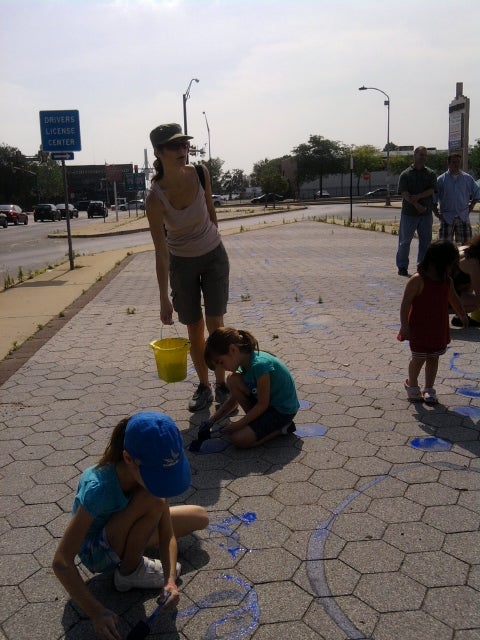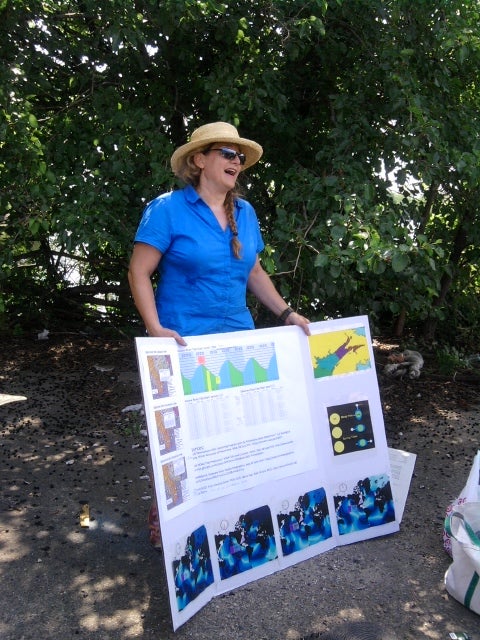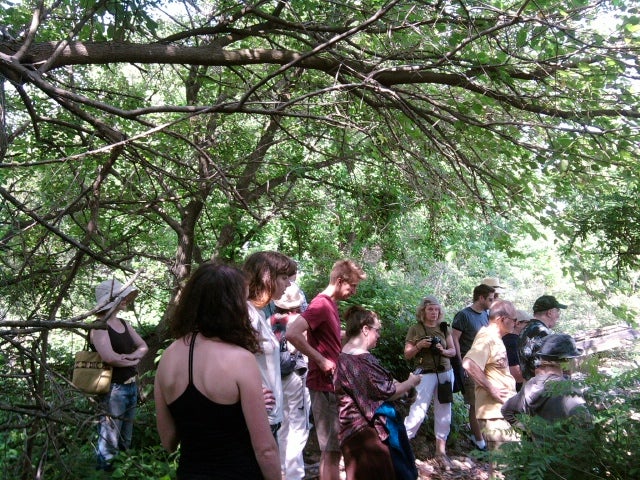The invisible becomes seen at site of future Pier 53 park
June 5, 2010
By Kellie Patrick Gates
For PlanPhilly
East Torresdale resident Jack Butler, 67, stooped to add another long swoosh of bright blue paint to Washington Avenue, while South Philadelphia sisters Carly and Chloe Lopez, ages 8 and 6, seemed to favor a curlicue style.
Under the guidance of environmental artist Stacy Levy, roughly two dozen people spent Saturday morning rendering three invisible aspects of the Delaware River into something that could be seen – and therefore, Levy hoped, better understood.
Levy is among the team of designers, ecologists and landscape architects who will transform a mostly-paved area at the foot of Pier 53 into a park. Set to open this fall, the park will be among the first projects in a long-range plan to redevelop the Central Delaware Waterfront.
Levy’s work will encorporate the natural elements of the space, so she has studied what nature does at and near the pier. She shared some of that knowledge Saturday through a series of activities that transformed the day into planning and design summer camp.

The paint and streams of light blue sand – intentionally leaked out from plastic bags as the group walked along the multi-use trail near the Coast Guard building and down a few blocks on Washington – represented a hidden tributary of the Delaware River, one of many that now flow underground in a sewer pipe. Seems crazy to bury a stream now, Levy said, but at the time, they were basically being used as open sewers. And capped off, they made a handy place to build a street, which is why the last above-ground trace many have left is a street sign bearing their names.
Before the creek mapping began, Levy and Ed Morgereth, project manager and senior ecologist with Biohabitats – the Baltimore company leading the design and construction of the new park – gathered everyone beneath a river-side mulberry tree for a brief talk about what the new park will include.
Paid for with $570,000 from the William Penn Foundation, Pier 53 park will be a place to commune with nature. It will be a broad, green oasis where people can take in the river and other natural elements, yet still see ships and industry. Those using the newly opened multi-use riverfront trail can take a break there.
For now, they said, the park will not include the tree-covered pier itself, except as a viewshed. In fact, most of what will be the park is now covered with pavement. Ripping it all up would be way too expensive, Levy said. “So we’re trying to work with existing conditions.”
She pointed out a small plant growing up through a crack, and described how its roots and the freeze-thaw cycle break apart pavement. “Most of the time, that’s a problem, if you’re trying to keep a parking lot intact,” she said.
“The plant roots are pushing against the concrete,” she said. “But we are going to turn that problem into an asset.” Portions of the pavement will be ripped up and planted immediately, she said. But in other places, only small cracks will be made, and plants inserted into those cracks. “We’re sort of doing a garden of controlled decay in order to break down a lot of the surface,” she said.
However, most of the three-hour workshop was not about talking.
After the creation of the blue, life-size creek map, everyone met back under the mulberry tree where Levy used charts – and later an apple and orange – to teach how the gravitational pull of the moon creates another element of the river that is hidden to many people: The tides.
At about 8:30 that morning – a half hour before the program began – Levy scooted down the pier to mark high tide with a series of painted-pink pebbles. A bit after 10 a.m., the water had already receded a good five feet from those stones.
The tide marking spot was maybe a minute’s walk from the mulberry tree at the edge of the Sheetmetal Workers Union Hall parking lot. But it seemed much further away. The Pier has an earthen center, and that earth has been claimed by berry brambles and trees. The shrieks of a hawk could be heard overhead. Cormorants stood sunning themselves on the remains of some wooden pilings.
A whole flotilla of Canada geese swam past. Later, Biohabitats ecologist Peter May said that meant special care would have to be taken when creating the park to use plants that geese don’t find especially tasty.
Some very high tides must have covered the pier, as large pieces of driftwood – some seemingly entire trees – were scattered around, as were human castoffs: Plastic and glass bottles, a tennis ball, a single sneaker.
Levy brought everyone into the union hall for the final invisible river lesson on microscopic organisms. She spoke of tiny creatures that use a moving ring of hairs to vacuum food into their mouths, and others that have long, hair-like protrusions they beat to propel themselves through the water.
Then she passed out multi-colored construction paper, pencils, scissors and metal fasteners, and everyone used them to create their own microorganism.
Philadelphians drink from their rivers – after some work by the water department, of course – and attendees also got to do a taste test comparing water from the Delaware to water from the Schuylkill. East side residents’ taps flow with Delaware water, Levy said, and west side residents’ taps have Schuylkill. Most said the two tasted similar.
“I preferred the Delaware,” said Dianne Mayer, “but that’s probably because I’m used to it from home.”
The next Pier 53 park public session has an ecological focus, and will include information on the health of the river, and the creatures that live in it. PHS’s Amanda Benner said this workshop is scheduled for June 26. Learn more.
Contact the reporter at kelliespatrick@gmail.com
WHYY is your source for fact-based, in-depth journalism and information. As a nonprofit organization, we rely on financial support from readers like you. Please give today.























